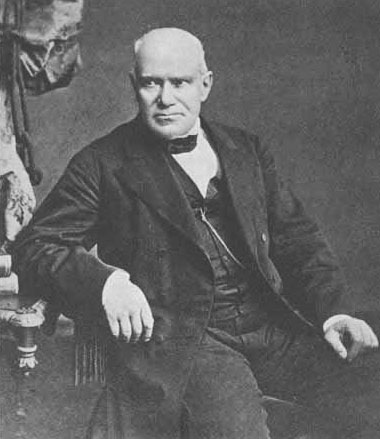Why bother to bone up on Steinitz? (2/2)
IM Craig Pritchett explains why we should all study the 19th Century Greats
Part One took the reader briskly through the history of the game’s so-called ‘Romantic Age’, from Bourdonnais’ early 1830s’ combinative example to the high point of those two great mid-century giants, Anderssen and Morphy. By the 1860s, chess knowledge had hugely expanded and these more innocent, open attacking times were ripe for seismic change.
Steinitz eventually evolved his own theory of the accumulation of small advantages. He and others, consciously or not, had to adapt. The evergreen Anderssen, who continued to compete successfully at the very top, despite giving away two decades or more to almost all of his peers in his last two decades, was among the successful adapters. Consider the following game, whose spectacular brilliance derives far less from anything ‘romantic’ in character than from the stricter dictates of a thoroughly sound and hard-hitting opening.

Adolf Anderssen (1818-1879) features in an instructive Everyman work by Pritchett, "Chess Secrets: Great Chess Romantics".
| Replay and check the LiveBook here |
Please, wait...
1.e4 e5 2.f4 d5 3.exd5 e4 4.Bb5+?! c6 5.dxc6 Nxc6 6.Nc3 Nf6 7.Qe2?! Bc5 8.Nxe4? 0-0 9.Bxc6 9.Nxc5 Re8 9...bxc6 10.d3 Re8 11.Bd2 Nxe4 12.dxe4 Bf5 13.e5 Qb6 14.0-0-0?! 14.Nf3 Qxb2 15.Rc1 Rab8 16.Qc4 Qa3 17.Nd4 Be4 14...Bd4 15.c3 Rab8 16.b3 16.Be1 Be3+ 16.b4 Qa5 17.Be1 Qa3+ 18.Qb2 Rxb4! 19.Qxa3 Be3+ 16...Red8 17.Nf3?! 17.cxd4 Qxd4 17.g4 Qa5 18.Kb2 Bc5 19.gxf5 Rxb3+ 20.Ka1 Rdb8 21.Be1 Qa3 22.Qc2 Rb2 23.Qb1 Qa4! 17.Kb2 Be6 18.Rb1 Bc5 19.Nf3 Qa5 20.Ka1 Rxb3 21.Rxb3 Bxb3 22.Bc1 Rb8 17...Qxb3‼ 18.axb3 Rxb3 19.Be1 Be3+! 0–1 - Start an analysis engine:
- Try maximizing the board:
- Use the four cursor keys to replay the game. Make moves to analyse yourself.
- Press Ctrl-B to rotate the board.
- Drag the split bars between window panes.
- Download&Clip PGN/GIF/FEN/QR Codes. Share the game.
- Games viewed here will automatically be stored in your cloud clipboard (if you are logged in). Use the cloud clipboard also in ChessBase.
- Create an account to access the games cloud.
| Rosanes,J | - | Anderssen,A | - | 0–1 | 1862 | C32 | Breslau m | |
Please, wait...
Steinitz also recognised that the great Paul Morphy would have effortlessly coped with the game’s changing trends, if he hadn’t abruptly ‘retired’ from all top-class competition, the ‘Pride and Sorrow’ of the game, at the very end of the 1850s.
Of Kolisch, who also effectively abandoned chess in the mid-1860s (eventually to become a wealthy financier, chess patron and Austrian ‘baron’), Steinitz allowed, too, not just that he “was gifted with most remarkable powers of originality, brilliancy and depth of combination [...] in the kingside attack”, but that in his most important encounters he also “showed some indications of the circumspective style which tends to hold the balance all over the board and seizes the slightest advantage at any point” (International Chess Magazine, May 1889).

Wilhelm Steinitz (1836-1900), the first official world champion and the subject of a fine "Move by Move" work by Craig Pritchett.
Life changes... even for ‘oldies’! In the next two or three decades, Steinitz changed his own game more radically than all of his peers and perhaps just as importantly gave expression to these momentous trends in chess not just in his many great games, but also in his incomparable writing, in The Field (1873-1882), International Chess Magazine (1885-1892), Modern Chess Instructor: Part 1 (1889) and elsewhere. Not just the world’s best player by acclaim (certainly through most, arguably all of the period, from around 1873 until the early 1890s), he was also a great teacher and, especially, chess innovator par excellence.
Contemporaries were certainly in awe of Steinitz’s remarkable facility for innovation. He pushed the boundaries of what most considered playable, at times, to extraordinary lengths. Among his greatest successes, to name but a few, must count:
-
His profoundly strategic reinterpretation of the long-neglected Salvio Gambit, which completely confounded Anderssen in their match, at London 1866, and his own, almost surreally conceived Steinitz Gambit, first unleashed on an unsuspecting world, at Dundee 1867.
-
Demonstrating the weak points in Anderssen’s favourite interpretation of Spanish: d3 Systems (generally involving an early Bxc6, followed by Nc3), and then subsequently refashioning the line (along myriad c2-c3 variants), which played an especially significant role in his world championship match victories against Zukertort (1886) and Chigorin (1889 and 1892).
-
Devising the first, recognisably modern anti-Isolated Queen’s Pawn defences, with which he repeatedly frustrated Zukertort’s attempts to attack (with White), in their 1886 match, and destroying Chigorin’s earliest attempts, in their 1889 match, at making his embryonic Chigorin Defence work, with a range of ideas that indicated an astonishingly accurate grasp of how to defuse such systems.
In addition to his profound chess understanding, it should also simply be stressed that Steinitz was a born fighter, who understood psychology and the value of calculated risk-taking and surprise in chess. Moreover he never lost his delight in combination or belief that tactics ultimately decide games. Far ahead of his time, Steinitz acted on the thoroughly modern principle that the scope in chess for innovation and test by concrete analysis was, in effect, near-endless. If he began to doubt any of his innovations, he would instantly ditch them.
It is scarcely possible to offer one game that provides more than the merest, limited insight into Steinitz’s great contribution to chess. Here, however, is one of my own personal favourites and one that is by any stretch of the imagination a combinational masterpiece. Any top 21st century player would be proud to play such a game, even today. It certainly takes us several other large steps from the Bourdonnais, Paulsen and Anderssen wins above to the very threshold of our own ‘modernity’.
| Replay and check the LiveBook here |
Please, wait...
1.e4 e5 2.Nf3 Nc6 3.Bb5 Nf6 4.d3 d6 5.c3 g6 6.Nbd2 Bg7 7.Nf1 0-0 8.Ba4 Nd7 9.Ne3 Nc5 10.Bc2 Ne6 11.h4! 11...Ne7 12.h5 d5 13.hxg6 fxg6?! 13...hxg6 14.Ng4 14.Qe2 14.exd5 Nxd5 15.Nxd5 Qxd5 16.Bb3 Qc6 17.Qe2 Bd7 18.Be3 Kh8 19.0-0-0 Rae8 20.Qf1! 20...a5 21.d4 exd4 22.Nxd4 Bxd4 22...Nxd4? 23.Rxh7+! Kxh7 24.Qh1+ 23.Rxd4 Nxd4?! 23...Re7 24.Rdh4 Rff7 25.g3! Kg8 26.Qd3 Qb5 27.Qxb5 Bxb5 28.Re1 a4 29.Bxa4 Bxa4 30.Rxa4 24.Rxh7+ Kxh7 25.Qh1+ Kg7 26.Bh6+ Kf6 27.Qh4+ Ke5 28.Qxd4+ 1–0 - Start an analysis engine:
- Try maximizing the board:
- Use the four cursor keys to replay the game. Make moves to analyse yourself.
- Press Ctrl-B to rotate the board.
- Drag the split bars between window panes.
- Download&Clip PGN/GIF/FEN/QR Codes. Share the game.
- Games viewed here will automatically be stored in your cloud clipboard (if you are logged in). Use the cloud clipboard also in ChessBase.
- Create an account to access the games cloud.
| Steinitz,W | - | Chigorin,M | - | 1–0 | 1892 | C65 | World Championship 04th | 4 |
Please, wait...
Along with other past (as well as present) greats, Steinitz continues to inspire me. What do you think?
Main Sources – my own Everyman Chess books:
- Heroes of Classical Chess (2009), especially the chapters on Rubinstein and Fischer;
- Giants of Innovation (2011), especially the chapters on Steinitz and Lasker;
- Great Chess Romantics (2013), especially the chapters on Anderssen and Chigorin;
- Steinitz: Move by Move (2015).
- And: Ignaz Kolisch: The Life and Chess Career, by Fabrizio Zavatarelli (McFarland & Company, 2015).
 |
About the author
IM Craig Pritchett (photo by Sally Pritchett) is a former Scottish champion and chess writer and retired Chartered Public Finance Accountant, who lives with his wife and two daughters in Dunbar, Scotland. Still an active national and senior international competitor, he narrates: "I knew long ago that I wouldn't be World Champion on that fateful day when Karpov took me out on board one at the 1974 Nice Olympiad, after I missed a winning line that, yes, was pointed out by Bobby Fischer and conveyed to the Scottish team by Tony Saidy a week or so later!"
Craig was a longstanding chess correspondent for The Glasgow Herald (1972-2006) and has published ten chess books. |
The above article appeared in the October 2016 of the British magazine CHESS

CHESS Magazine was established in 1935 by B.H. Wood who ran it for over fifty years. It is published each month by the London Chess Centre and is edited by IM Richard Palliser and Matt Read. The Executive Editor is Malcolm Pein, who organises the London Chess Classic.

CHESS is mailed to subscribers in over 50 countries. You can subscribe from Europe and Asia
at a specially discounted rate for first timers here, or from North America here.
ChessBase software from Chess & Bridge
 |
Master Class Volume 7: Garry Kasparov
Rogozenco, Müller, Marin & Reeh;
ChessBase PC-DVD, running time: 9 hours
RRP £24.95 SUBSCRIBERS £22.45
ChessBase’s series on the greatest players of all time moves on to tackling one who is still very much with us, the legendary 13th world champion. Kasparov may have been retired for 11 years now, but we can, of course, still learn a huge amount from his games.
As usual Müller, Marin and Reeh explore his endgame, strategic and tactical skills respectively, while Rogozenko is a welcome addition to the team as he examines one of Kasparov’s legendary strengths, his openings.
Order online from
The London Chess Centre or Chess4Less (USA) |
 |
The 4...Nf6 Caro-Kann
Nigel Davies; ChessBase PC-DVD,
running time: 4 hours
RRP £24.95 SUBSCRIBERS £22.45
The Welsh Grandmaster takes a look at the main line of the Caro-Kann, 1 e4 c6 2 d4 d5 3 Nc3 dxe4 4 Nxe4, proposing Black then plays an old favourite of his, 4...Nf6. After 5 Nxf6+ Davies examines both the Tartakower variation, 5...exf6, and the more dynamic Bronstein-Larsen line, 5...gxf6!?. As one would expect,
Davies explains the main ideas for Black, while mapping out a repertoire with both variations which should be sufficiently detailed for the club player.
Order online from
The London Chess Centre or Chess4Less (USA) |
 |
Pawn Structures You Should Know
Adrian Mikhalchishin; ChessBase PC-DVD,
running time: 5 hours, 6 minutes
RRP £24.95 SUBSCRIBERS £22.45
The experienced Slovenian, formerly Ukrainian, Grandmaster and trainer has long been a fan of Aron Nimzowitsch’s advice that one must “study typical pawn structures”. Mikhalchishin has plenty of clear examples, which help to illustrate how one should handle both sides of such common situations as the isolated pawn or the Marozcy Bind, while a number of interactive tests should serve to really drum home the lessons.
Order online from
The London Chess Centre or Chess4Less (USA) |
 |
Trompowsky for the Attacking Player
Timur Gareyev; ChessBase PC-DVD,
running time: 4 hours, 36 minutes
RRP £24.95 SUBSCRIBERS £22.45
On his early summer trip to Europe, Gareyev dropped by Hamburg, recording this DVD on one of his all-time favourite openings. As one might expect, there is plenty of creative, sharp chess to be found in this Trompowsky repertoire, with gambits very much to the fore. That said, Gareyev does also show how to handle Black’s more solid defences while drawing heavily on his own praxis throughout.
Order online from
The London Chess Centre or Chess4Less (USA) |
































